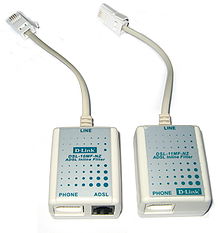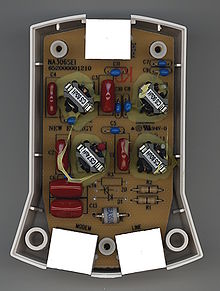- DSL filter
-
"Splitters" redirects here. For other uses, see Splitter (disambiguation).
A DSL filter is an analog low-pass filter installed between analog devices (such as telephones or analog modems) and a plain old telephone service (POTS) telephone line, in order to prevent interference between such devices and a digital subscriber line (DSL) service operating on the same line. Without DSL filters, signals or echoes from analog devices at the top of their frequency range can result in reduced performance and connection problems with DSL service, while those from the DSL service at the bottom of its range can result in line noise and other issues for analog devices.
Typical installation for an existing home involves installing DSL filters on every telephone, fax machine, voice band modem, and other voiceband device in the home, leaving the DSL modem as the only unfiltered device. For wall mounted phones, the filter is in the form of a plate which hangs on the standard wall mount, and upon which the phone hangs in turn.
In cases where it is possible to run new cables, it can be advantageous to split the telephone line after it enters the home, installing a single DSL filter on one leg and running it to every jack in the home where an analog device will be in use, and dedicating the other (unfiltered) leg to the DSL modem. Some devices, such as monitored alarms and Telephone Devices for the Deaf, mainly certain older models using an acoustic coupler, may be hardwired and may not easily accept a DSL filter. Some of these devices can be successfully filtered with a DSL filter or splitter, especially if the hardwired connection is converted into a jacked connection.
Some DSL modems have filtering circuitry built-in, to which the telephones and fax machines can be connected.
Protocols and specifications
- ITU G.992.1 (G.DMT),
- ITU G.992.2 (G.Lite)
- ITU G.992.5 (G.DMT2+)
Categories:- Digital Subscriber Line
- Electronic filter applications
Wikimedia Foundation. 2010.


